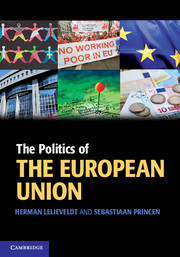Book contents
- Frontmatter
- Contents
- Acknowledgements
- List of briefings
- List of fact files
- List of controversies
- List of tables
- List of figures
- List of abbreviations and acronyms
- List of country abbreviations used in tables and figures
- Preface
- PART I Setting the scene: origins, analytical perspectives and institutions
- PART II Key actors in EU politics: citizens, interest groups and political parties
- Part III EU policies: agenda-setting, decision-making and implementation
- Conclusions and reflections
- 12 Reflecting on the EU as a political system
- Key terms and concepts
- Index
12 - Reflecting on the EU as a political system
from Conclusions and reflections
- Frontmatter
- Contents
- Acknowledgements
- List of briefings
- List of fact files
- List of controversies
- List of tables
- List of figures
- List of abbreviations and acronyms
- List of country abbreviations used in tables and figures
- Preface
- PART I Setting the scene: origins, analytical perspectives and institutions
- PART II Key actors in EU politics: citizens, interest groups and political parties
- Part III EU policies: agenda-setting, decision-making and implementation
- Conclusions and reflections
- 12 Reflecting on the EU as a political system
- Key terms and concepts
- Index
Summary
Introduction
When the crisis on the financial markets hit Europe in late 2008, this was generally seen as a grave test for the European Union. Would it be able to respond in the face of crisis? Would member state governments be able to overcome their longstanding differences of opinion on economic and financial policy in finding new solutions? And would the EU's institutional framework of budgetary and free-trade rules be able to withstand the flurry of national support measures and calls for economic protectionism that occurred throughout the member states? The situation became even more serious when the Euro itself came under attack from financial markets after fears had arisen that Greece, and possibly a number of other member states, would be forced to default on their (fast-rising) government debts.
As it turned out, the financial crisis proved a tremendous impetus for European cooperation. Even though member state governments took an unprecedented number of far-reaching measures (nationalizing banks, letting government debt rise in order to stimulate their economies), the lapse into protectionism and unilateralism did not occur. Instead, in most cases member state governments closely consulted on the steps to take and tried to find solutions that would keep up existing EU rules while taking account of the special circumstances.
- Type
- Chapter
- Information
- The Politics of the European Union , pp. 277 - 298Publisher: Cambridge University PressPrint publication year: 2011



